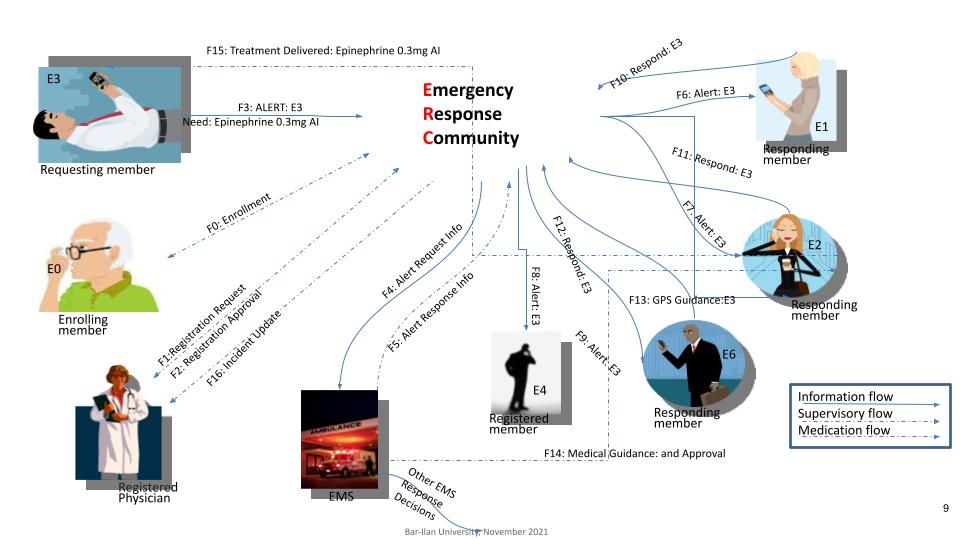Our approach to the use of social networks for emergency response is based on a new conceptualization of ‘social medicine’ (SM). We have all heard, or asked, some form of the question: “I have a headache – do you have an aspirin?” We’ve asked colleagues, flight attendants, teachers, cab drivers – and have offered the same when asked. The archetypal question being asked and answered in our conceptualization of social medicine is “Do you have an aspirin?” where “aspirin” is replaced with a critical life-saving treatment and “you” is replaced with millions of people, any one of whom may be carrying such a treatment nearby at any given time. As the prevalence of chronic conditions continues to rise, by creating Emergency Response Communities (ERC's) around chronic conditions such as acute allergies, asthma, diabetes, or heart disease, we have the ability to reshape society’s response to individuals in medical distress – by reshaping the response of individuals in our society. Our most recent extension of the ERC concept is now being studied as an opioid overdose intervention for the emergency provision of naloxone (See the UnityPhilly Project).
This international initiative brings together researchers in information and communications technologies, social networking, and crowd behavior, with leading medical specialists from the fields of Emergency Medicine, Emergency Medical Response, and Public Health, alongside medical domain experts from a range of chronic diseases including Allergy and Asthma, Addiction, Diabetes, and COPD.
Related publications include:
-
Khalemsky M, Bellou A, Karamercan MA, Möckel M, Garcia Castrillo L, Schwartz DG, Physicians' attitudes towards smartphone-based emergency response communities for anaphylaxis: Survey, Health Policy and Technology, Volume 11, Issue 1, 2022, 100580, https://doi.org/10.1016/j.hlpt.2021.100580.
-
Khalemsky, M., Schwartz, D.G., Herbst, R., and Jaffe, E. Motivation of Emergency Medical Services Volunteers: A Study of Organized Good Samaritans, Israel Journal of Health Policy Research, 9(11), 2020. https://doi.org/10.1186/s13584-020-00370-9
-
Gaziel-Yablowitz M., Dolle S., Schwartz D.G., & Worm M., Proximity-based Emergency Response Communities for allergy patients at risk of anaphylaxis: Clustering Analysis and Scenario-Based Survey Study, JMIR Mhealth Uhealth, 7(8):e13414, 2019 http://dx.doi.org/10.2196/13414
-
Khalemsky M., Schwartz D.G., Silberg T., Khalemsky A., Jaffe E., & Herbst R., Willingness to Join a Smartphone-based Emergency Response Community: Evidence from a Field Study, JMIR Mhealth Uhealth, 7(8):e13892, 2019 http://dx.doi.org/10.2196/13892
-
Gaziel-Yablowitz, M., & Schwartz, D. G., A Review and Assessment Framework for Mobile-Based Emergency Intervention Apps. ACM Computing Surveys (CSUR), 51(1), 15, 2018. https://dl.acm.org/citation.cfm?id=3145846
-
Khalemsky, M., and Schwartz D.G. Emergency Response Community Effectiveness: a simulation modeler for comparing Emergency Medical Services with smartphone-based Samaritan response, Decision Support Systems, 102, pp. 57-68, 2017. http://www.sciencedirect.com/science/article/pii/S0167923617301252.
-
Schwartz, D.G., Bellou, A., Garcia-Castrillo, L., Papadopoulos, N., and Muraro, A., Exploring mHealth Participation for Emergency Response Communities. Australasian Journal of Information Systems, vol. 21, mar. 2017. ISSN 1449-8618. Available at doi:http://dx.doi.org/10.3127/ajis.v21i0.1378.

